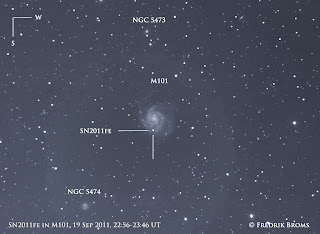Last night, the heavy cloud-cover that has been parked over Northern Norway lately finally permitted an opportunity to look at the night sky.
The recent supernova that erupted in our galactic neighbourhood (in the Pinwheel Galaxy, M101) that I reported on earlier (
http://nordlysfoto.blogspot.com/2011/08/supernova-explosion-in-pinwheel-galaxy.html), could be seen visually without problem even in modest equipment (in my case a spotting scope for birds at lowest magnification (20x). The moon, 50% of full, washed away much of the light of the galaxy itself (which I could only see using averted vision), but the supernova itself proved easier to see than the galaxy.
SN2011fe in M101 - 19 September 2011
Supernovae occur when stars collapse at the end of their lifes and trigger an enourmous explosion that may outshine an entire galaxy for a period of time. This particular supernova, designated SN2011fe or PTF11kly, has now climbed to approximately 10th magnitude according to recent estimates. The last time such a close-by bright supernova could be seen was back in 1972, and only a handful of such bright and close SN`s are known since the middle-ages, so and if you want to see this rare sight, now is the time before it fades! Right now, the exploded star shines brighter than it`s host galaxy and will probably stay bright and stable for yet some time to come.
How to find it and to see it? It is well placed in the sky for us living in the northern hemisphere. The host galaxy (M101) can be found close to the perhaps most well-known star-pattern in the sky - The Big Dipper also known as The Plough or the Saucepan (Ursa major). Once you have located the Big Dipper, finding the place for the supernova is fairly easy, but you will need to let your eyes get dark-adapted before you give it a try. Stay outside in a dark place away from any artificial light sources for at least half an hour before giving it a try.
If you have a pair of binoculars, a spotting scope or a telescope, you should then go to the last to stars in the handle of the Big Dipper. Then, imagine a triangle with the two last stars forming the base and the galaxy with the SN forming the top as shown in this map of the Big Dipper:
http://irishastro.org.uk/m101supernova.html. At the top of the imaginary triangle, a faint smudge (being the galaxy) can be seen and the supernova should be clearly visible as a "new" bright white star. A good way of finding the SN is to take a picture of the area - the SN really stands out even in short exposures.
Inverted image of M101
Above is a picture from yesterday evening (19 Sept 2011) taken with a Nikon DSLR with a 300mm lens, exposure time 30 seconds at ISO 1250. To reduce noise, I have combined several 30 sec exposures, but the SN is so bright that it would easily be picked up in even shorter exposures.
For the most recent images and reports, this is a good page:
http://www.rochesterastronomy.org/sn2011/sn2011fe.html
Can`t find the bloody thing anyway?
Don`t despair, there`s plenty of other wonders in the night sky. Maybe it was because I have had a dull grey rain-cloud the size of a galaxy over my head lately, but wherever you look in the night sky, there`s plenty to enjoy!
Early in the evening, the moon shone over the autumn coloured landscape with the Milky Way high in the evening sky, later to be joined by some faint aurorae.
The Milky Way
Autumn evening with the Milky Way and Auroras
While the night grew older, the Moon climbed higher with Jupiter shining brilliant by its side, I tried to see what had happened to the comet (C/2009 P1 Garradd) since the last time I had clear skies. Not really expecting to see it with binoculars on a bright night like this, I was surprised how easy it was to find. Now in the constellation of Hercules, the comet keeps wandering over the night sky:
http://cometchasing.skyhound.com/comets/2009_P1.pdf, and was a delight to see against the rich star fields. Below is a single-30 sec -exposure of the comet with a 300mm lens and a DSLR.
Comet C/2009 P1 Garradd
Around midnight, I decided to call it the night and stumbled around for a while in the backyard before hitting the bed. Autumn nights are beautiful, but so are autumn days - and the Moon can be seen all day among the yellow autumn leaves.
The backyard around midnight
Morning Moon





























